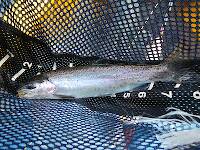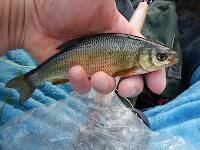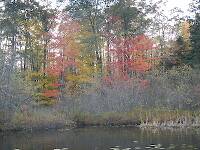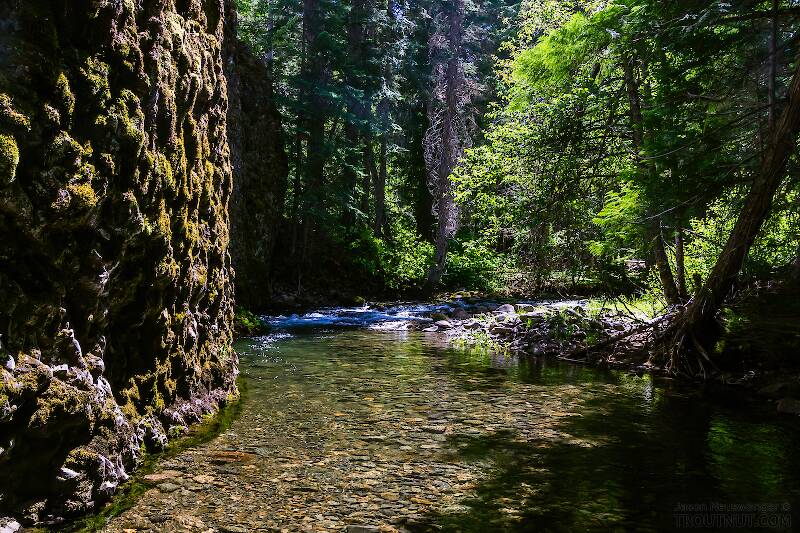
Hex Mayflies
Hexagenia limbata
The famous nocturnal Hex hatch of the Midwest (and a few other lucky locations) stirs to the surface mythically large brown trout that only touch streamers for the rest of the year.
Featured on the forum

This one seems to tentatively key to Holocentropus, although I can't make out the anal spines in Couplet 7 of the Key to Genera of Polycentropodidae Larvae nor the dark bands in Couplet 4 of the Key to Genera of Polycentropodidae Larvae, making me wonder if I went wrong somewhere in keying it out. I don't see where that could have happened, though. It might also be that it's a very immature larva and doesn't possess all the identifying characteristics in the key yet. If Holocentropus is correct, then Holocentropus flavus and Holocentropus interruptus are the two likely possibilities based on range, but I was not able to find a description of their larvae.

Troutnut is a project started in 2003 by salmonid ecologist Jason "Troutnut" Neuswanger to help anglers and
fly tyers unabashedly embrace the entomological side of the sport. Learn more about Troutnut or
support the project for an enhanced experience here.
Strmanglr on Nov 14, 2011November 14th, 2011, 12:01 pm EST
Any of you guys ever try skating flies for steelhead? I haven't and it would seem to me it would be about the least productive method of fly fishing for steelhead. Although, could be very exciting to hook up like that. I've tied a couple skaters but I just can't believe and end up using something else.
Wbranch on Nov 14, 2011November 14th, 2011, 12:26 pm EST
I've done it but you need some things in your favor like water temperature no less than 50 degrees, suspended fish that are interested in eating and have not been pounded, and some patience as it may take some time to irritate one enough to come up and eat your bug.
Catskill fly fisher for fifty-five years.
Sayfu
Posts: 560
Posts: 560
Sayfu on Nov 14, 2011November 14th, 2011, 12:29 pm EST
Anything but the least productive....all about time, and place. When the water temp is right and fish lying in a tailout especially as they often do, it can be the most effective way to get a steelhead to react to your offering. Steelhead are territorial, and the wake of a fly entering their territory either causes them to flee, or defend, their territory. As the fly approaches it appears to the fish to be approaching much closer than when it reaches overhead. Draw an angle out to the side and up, rather than a line straight up. Whether is a defensive reaction, or just inquisitive it sure can be effective. I caught lots of steelhead in the Fall of the year before the water got too cold. The water was low, clear water, and most of the fish I caught were hatchery origin. I used a smaller, waking fly than the big, aggressive, native fish that can be caught with this method on the Skeena System in BC for instance. They often use much bigger patterns causing more wake. I took a steelhead using this very method after a boat angler went through fishing bait, and didn't know I was approaching behind him. They heard the splash after the fist jump, and looked back. They pulled their driftboat over to the bank, and walked back to where I was anchored. The guy wanted to know "how in the world?" I told him that the steelhead I had on was just looking up, and was more receptive to that presentation than something bounced along the bottom. And that is exactly what can happen with steelhead in the Fall. They react very well to surface, or dragging flies in the film. Nothing like it. I go to bed dreaming about that method a lot.
Jmd123 on Nov 14, 2011November 14th, 2011, 7:09 pm EST
Strmanglr, if you do this and it works, please let me know!!! I'm just not into bottom-dredging on a fly rod.
Jonathon
Jonathon
No matter how big the one you just caught is, there's always a bigger one out there somewhere...
Entoman on Nov 15, 2011November 15th, 2011, 1:57 pm EST
Anything but the least productive....all about time, and place
I agree. I've had excellent salmon fishing on the Margaree R., NS where Bombers are a bit of a religion and nothing else was tied to the end of the leader for weeks at a time. I've also done well in the Skeena system before it gets cold. The Dechutes in Oregon and the half-pounders on the Klamath also like waking patterens. A curious thing about steelhead (as opposed to salmon) is that the dry will mark fish and you can often follow up with a small wet fly for solid hook-ups.
I go to bed dreaming about that method a lot.
Boy you did have it bad, Seyfu.:) I have to agree there's nothing more heart stopping than a large salmon or steelhead boiling your fly. (I'm sure Tony will add some saltwater denizens to the list.)
Regards,
Kurt
"It's not that I find fishing so important, it's just that I find all other endeavors of Man equally unimportant... And not nearly as much fun!" Robert Traver, Anatomy of a Fisherman
Entoman on Nov 15, 2011November 15th, 2011, 4:17 pm EST
BTW - I assumed we are talking about "waking" not "skating". They are two entirely different things. If the latter, forget what I said as I have no experience with it regarding salmon & steelhead.
"It's not that I find fishing so important, it's just that I find all other endeavors of Man equally unimportant... And not nearly as much fun!" Robert Traver, Anatomy of a Fisherman
Bcvizina on Nov 16, 2011November 16th, 2011, 9:34 am EST
I'm not sure if we're talking about "waking" or "skating", but if I understand correctly, it is accomplished by casting downstream and adding slack to the line to achieve a drag-free float. Then, you add a twitch to the fly to regain some of the line control (get rid of excess slack), and continue the drift.
This is my question, at the end of your drift, how do you retrieve the fly? I'm always concerned about putting down the fish I was just over. I've tried stripping it back slowly as well as twitching it back to me.
I thought it to be a pretty popular technique for fishing dries, but never heard anyone address the retrieve associated with the technique.
This is my question, at the end of your drift, how do you retrieve the fly? I'm always concerned about putting down the fish I was just over. I've tried stripping it back slowly as well as twitching it back to me.
I thought it to be a pretty popular technique for fishing dries, but never heard anyone address the retrieve associated with the technique.
Sayfu
Posts: 560
Posts: 560
Sayfu on Nov 16, 2011November 16th, 2011, 5:31 pm EST
No, not the way I fish it..the fly DRAGGED. Generally the cast would be made quartering down slightly and across to get the fly started first, A mend would be made just like the wet fly swing. The speed of the fly going down and across would be controlled by mends, and the rod tip. If the fly stalled down, and out from you, you might make a reverse mend towards your bank to continue the swing of the fly. Tension was maintained on the line with no intension of getting a drag free drift. It was the drag of the fly across, and towards the steelhead's lie that brought about the take. You may be thinking of the Jock Scott's "Grease Line" presentation method that, I think, is a drag free method of presenting the fly broadside, and maintaining that broadside presentation throughout the drift. Mine dragged, and created a slight wake without any special knot used.(forgot the name of the knot they use to create a wake) It involved some half-hitches applied, and I never liked it, or felt that I needed it. My waking fly presentation was basically the same way I fish a soft hackle most of the time. And a slight wake could be assisted by the flies design such as a muddler head, or an elk-haired caddis type fly with the head design creating a wake.
Entoman on Nov 16, 2011November 16th, 2011, 6:29 pm EST
Strmangler -
I'm still not sure which method you were referring to. If by skating you mean moving the flies with rod twitches and line strips, I know it is a good technique for trout at times, but I don't know if it would work for steelhead. I admit slavery to convention and always wake 'em, trying to get the speed of the cross as slow and consistent as possible. If for no other reason than because that's the way I was taught, I guess. Perhaps skating (if you mean as described above) would work quite well in certain circumstances.
Sayfu -
The knot you were trying to remember is the Riffle hitch. All it really is a half hitch or two thrown back behind the head of the fly after knotting it to the tippit. I have a guide buddy in Terrace that experimented with tying muddler heads on a piece of weed wacker nylon lashed to the top of a down eye hook. It extending out over the eye to accomplish the the same thing. I've never used them much, but he swears by them. I was thinking of experimenting with the concept for trout flies to simulate October caddis or big stoneflies skittering towards shore, but never got around to it. Maybe I'll tie some up for next year...:)
Regards,
Kurt
"It's not that I find fishing so important, it's just that I find all other endeavors of Man equally unimportant... And not nearly as much fun!" Robert Traver, Anatomy of a Fisherman
Sayfu
Posts: 560
Posts: 560
Sayfu on Nov 17, 2011November 17th, 2011, 4:21 am EST
I think your Deschutes waters offers some dry fly waking, and skating. The temp has to be conducive, and some Fall water rivers get just too cold too early. Steelhead can be very aggressive to the surface fly, and many Fall times, and I had a 60 day window of opportunity before the rains muddied up the water, and the water turned too cold many years. Very few anglers were on the water competing with me at that Fall time as well. The ones that were on the water fished higher up in the system near the hatchery/rearing ponds. I was down river 2-3 miles where fish would hold up in no hurry to enter the hatchery, and were content to wait for the higher water to bring them up. I remember one day fishing a run, and an angler approached me having fished the water. His rod was bamboo, and his reel an "S" handle Bogdon (sp?)reel. The guy was very willing to converse, and showed me his fly box....all small for steelhead #12's and #14 dry flies. I can remember the Adam's flies he showed me. I asked him if he fished them dead drift? He said yes, that was the challenge he enjoyed. He would often see a steelhead rise, then get into position, and present the dry fly over it. He told me there were days when it just didn't work, but then there were days. I didn't want to be challenged that much. The big tug was given priority over the challenge, and I dragged my flies, and waked them with good results. I often took a rookie angler who would have difficulty hooking a trout with their skills as a caster/angler, and hook them up to a steelhead by dragging the fly, sometimes directly in front of the big boulder where I knew one was laying. The discipline was to get them to NOT set the hook on the visible big swirl!!! That was difficult for me to even do many times!
Gutcutter on Nov 17, 2011November 17th, 2011, 8:14 am EST
(I'm sure Tony will add some saltwater denizens to the list.)
Not really.
Most of my saltwater fishing is sight fishing, and watching a tarpon or permit react to an accurate cast and appropriate imitation and most importantly lifelike manipulation of the fly will result in a take. That is the technical part. Once the fish is on, the adrenaline rush kicks in.
Now, I haven't been fortunate enough to catch (or fish for) steelhead in this manner, but I have caught Landlocked Atlantics and Alaskan Silvers that way, and I have to agree, it is heartstopping. Seeing the shadow, and then the wake and ending in a boil followed by a tremendous jerk on the rod...
Blind casting for muskies is the only thing in my experience that comes close
All men who fish may in turn be divided into two parts: those who fish for trout and those who don't. Trout fishermen are a race apart: they are a dedicated crew- indolent, improvident, and quietly mad.
-Robert Traver, Trout Madness
-Robert Traver, Trout Madness
Strmanglr on Nov 21, 2011November 21st, 2011, 6:37 am EST
Sorry for my absence on this subject, I just can't get online that much.
Sayfu has it the way I learned it, basically the same as the way I fish spiders, cast on the quarter down, adjust line tension as needed with a little mend and get a nice wake. Start on the opposite side of the fish, let the dry "skate" in to the holding area of suspicion and hopefully that big arse fish remembers what it means to feed off the top. I've never fished it successfully but I haven't really put in the time either.
I suppose you could double the rig and do a skater with a wet below.
http://youtu.be/0Ql2OFU5Ncs This is an example on you tube I quickly pulled up. I don't spey fish now, maybe if I got a convertible rod.
I googled steelhead skating flies under images and saw some I recognized and some new of course too.
Sayfu has it the way I learned it, basically the same as the way I fish spiders, cast on the quarter down, adjust line tension as needed with a little mend and get a nice wake. Start on the opposite side of the fish, let the dry "skate" in to the holding area of suspicion and hopefully that big arse fish remembers what it means to feed off the top. I've never fished it successfully but I haven't really put in the time either.
I suppose you could double the rig and do a skater with a wet below.
http://youtu.be/0Ql2OFU5Ncs This is an example on you tube I quickly pulled up. I don't spey fish now, maybe if I got a convertible rod.
I googled steelhead skating flies under images and saw some I recognized and some new of course too.
Seatrout on Apr 16, 2012April 16th, 2012, 3:53 am EDT
You can also tie flies on a plastic tube and make a hole on the side. it floats much better and is an easier way of keeping the fly on the surface. Check out this post:
http://fishingvlog.com/the-riffle-hitch/
It works well for salmon and I´m looking for the chance to try if for sea trout.
http://fishingvlog.com/the-riffle-hitch/
It works well for salmon and I´m looking for the chance to try if for sea trout.
Quick Reply
Related Discussions
Topic
Replies
Last Reply
6
Mar 12, 2015
by Feathers5
by Feathers5
5
Oct 31, 2011
by Oldredbarn
by Oldredbarn
They're STILL eating my hoppers! Plus, a very large minnow... 




In the Photography Board by Jmd123
+ 1





In the Photography Board by Jmd123
0
Oct 23, 2016
by Jmd123
by Jmd123







